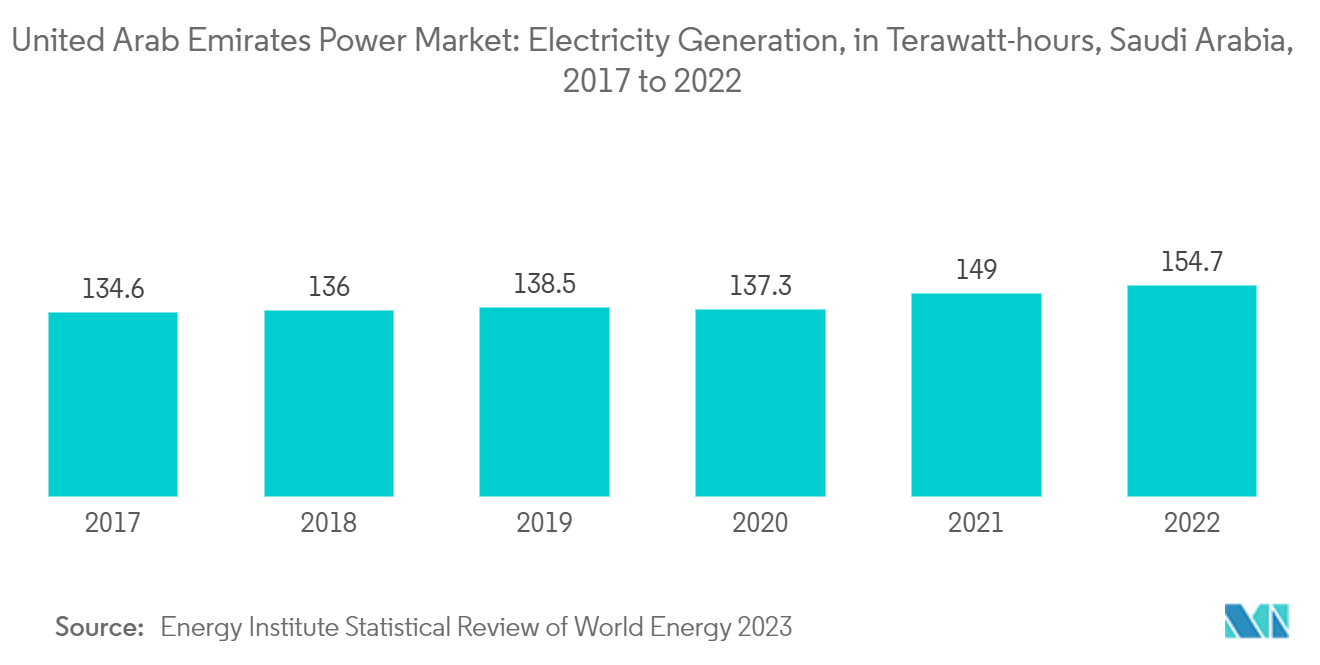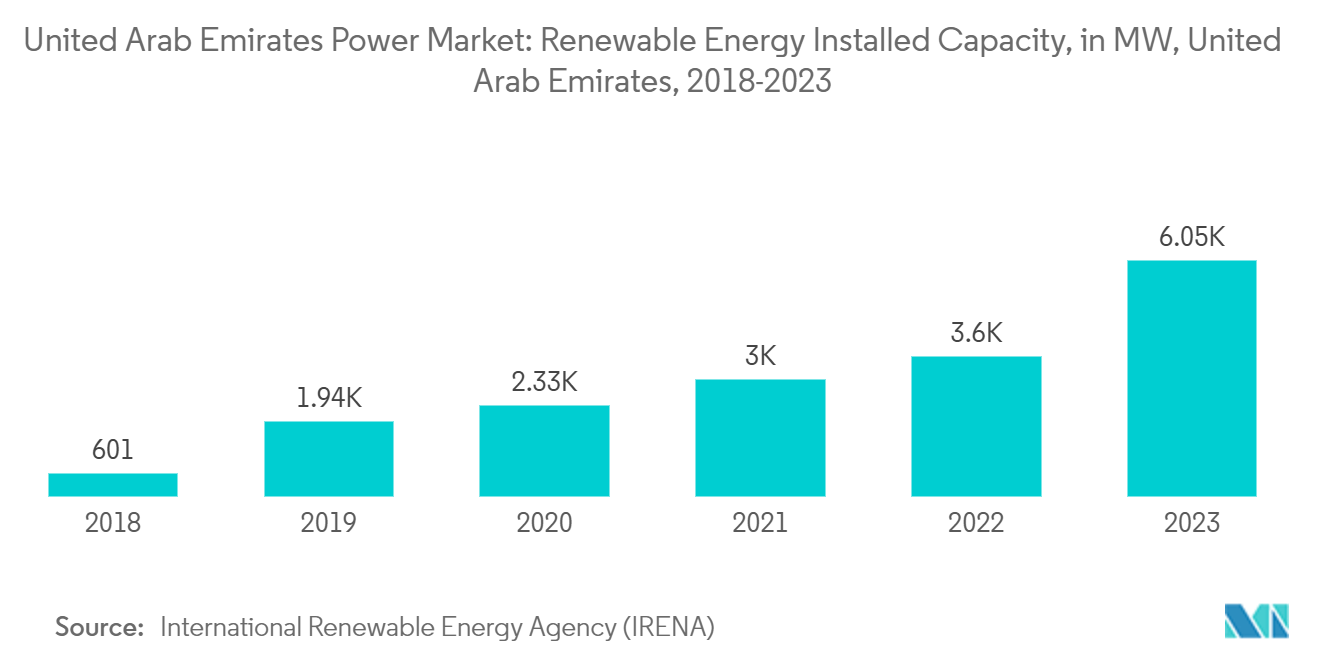Market Trends of UAE Power Industry
The Thermal Segment to Dominate the Market
- The United Arab Emirates possesses significant natural gas reserves, making it a reliable and cost-effective energy source for power generation. The country has invested in exploration and development activities to enhance its gas production capacity, ensuring a stable supply for the power sector.
- Natural gas has been the primary source of power generation in the United Arab Emirates, accounting for a substantial majority of the electricity produced. The country has significant natural gas reserves, and this resource has been relatively cost-effective and reliable.
- According to the United States Energy Information Administration, the United Arab Emirates held an estimated 290 trillion cubic feet (Tcf) of proven natural gas reserves at the beginning of 2023, up from the previous year's 273 trillion cubic feet (Tcf).
- At present, United Arab Emirates (UAE) generates 82% of its electricity from natural gas. The rest includes nuclear, solar, and wind power. According to data from the Energy Institute Statistical Review of World Energy 2023, there was an increase in electricity generation in the United Arab Emirates in 2022.
- The United Arab Emirates Energy Strategy 2050 aims to achieve a well-balanced energy mix that addresses the country's economic needs and environmental objectives. The strategy targets a combination of renewable, nuclear, and clean energy sources, intending to comprise 44% clean energy, 38% gas, 12% clean coal, and 6% nuclear in the overall energy composition.
- For instance, as of 2024, the United Arab Emirates has 37 gas-fired power plants. The country is focused on expanding the fleet of natural gas-fired power plans, which is expected to create tremendous opportunities in the transmission and distribution segment. For instance, in October 2023, GE Vernova, the Sharjah Electricity, Water and Gas Authority (SEWA), and Sharjah Hamriyah Independent Power Company (SHIPCO) began commercial operations at the 1.8GW Hamriyah independent power plant (IPP) in Sharjah, United Arab Emirates (UAE).
- For instance, in February 2023, Fujairah Terminals successfully managed the transportation of three of the largest gas turbines ever deployed in the United Arab Emirates. The Fujairah F3 Power Plant Project will likely be the largest Combined Cycle Power Plant (CCPP) facility in the United Arab Emirates, which was expected to be operational in 2023. Its substantial capacity is expected to generate enough electricity to meet the needs of approximately 380,000 households nationwide.
- Owing to these developments, the natural gas-fired power generation segment will likely have a significant share in the future.

Transition Toward Renewable Energy to Drive the Market
- The United Arab Emirates, renowned for its substantial oil reserves and significant contributions to the global oil and gas industry, is at a crossroads marked by a rapidly evolving global energy landscape. The pervasive shift toward renewable energy sources driven by mounting environmental concerns and the imperative to mitigate climate change has cast a shadow over the future of traditional fossil fuel industries.
- The Energy Ministry of the United Arab Emirates announced in July 2023 that the country aims to produce 1.4 million tonnes of hydrogen annually by 2031. Projections suggest that this amount will increase tenfold to 15 million tonnes by 2050.
- As part of its updated energy strategy, the nation aims to substantially augment its renewable energy capacity, targeting a threefold surge from 3.2 GW to an impressive 14 GW by 2030. This strategic initiative is poised to significantly reduce total energy generation costs, with estimates anticipating a decline ranging from AED 100 to 150 billion by the end of 2030.
- In line with its Energy Plan for 2050, the United Arab Emirates (UAE) is actively pursuing diversification of its power mix. The plan outlines an ambitious vision that includes generating 44% of the country's electricity from renewable sources, 6% from nuclear energy, 12% from clean coal, and the remaining portion from natural gas by 2050. To support this transition and meet the increasing energy demand while fostering sustainable economic growth, the United Arab Emirates aims to invest USD 160 billion by 2050.
- The United Arab Emirates is also expected to increase the power generation capacity from onshore wind farms. The UAE's electricity grid saw its first large-scale utility wind power project in 2023. The 103.5-megawatt (MW) landmark project is spanned in four locations, including Sir Bani Yas Island in Abu Dhabi, where a 45 MW capacity wind farm plus 14 MWp (megawatt peak) solar farm has been developed, expanding on existing wind power facilities on the island. The other wind farm locations include Delma Island (27 MW), Al Sila in Abu Dhabi (27 MW), and Al Halah in Fujairah (4.5 MW).
- Several of the UAE's private companies in the renewable energy segment are preparing to invest to achieve net zero by 2050. For instance, in January 2024, the Renewable EPC arm of Larsen & Toubro’s Power Transmission & Distribution business was chosen as the turnkey engineering, procurement, and construction contractor to establish an 1800 MWac Solar Photovoltaic Plant in Dubai, United Arab Emirates. The project is the sixth phase of the Mohammed bin Rashid Al Maktoum Solar Park, spread over 20 sq. km. In addition to the photovoltaic plant, the scope includes related evacuation and interconnection arrangements, including two gas-insulated substations, high-voltage underground cabling, and medium-voltage distribution networks.
- According to the International Renewable Energy Agency, the country's installed renewable energy capacity has grown significantly. In 2023, the total installed renewable energy capacity was 6,052 GW, with a growth rate of almost 68.3% compared to 2022.
- These developments to increase renewables' share in the power generation segment will likely bolster market growth.


